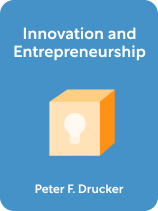

This article is an excerpt from the Shortform book guide to "Innovation and Entrepreneurship" by Peter F. Drucker. Shortform has the world's best summaries and analyses of books you should be reading.
Like this article? Sign up for a free trial here.
How can you gain an entrepreneurial mindset? How are entrepreneurship and innovation different?
Entrepreneurship and innovation are buzzwords used so often that their true meanings have eroded. Peter F. Drucker argues that entrepreneurship requires more than simply starting a new business and that innovation takes many shapes beyond inventing new products or techniques.
Let’s look at Drucker’s definitions of innovation and entrepreneurship to understand how to have an entrepreneurial mindset.
Understanding the Entrepreneurial Mindset
What is an entrepreneurial mindset? Having this type of mindset means creating new markets and new customers. An entrepreneur brings about change by introducing novel products, services, or business models that disrupt the status quo. This ability isn’t limited to small startups—even large corporations can be entrepreneurs. Likewise, entrepreneurship isn’t confined to the business world—nonprofits can also introduce new ideas and challenge the traditional ways they operate. At its core, entrepreneurship is a mindset that embraces change as a normal and necessary force in society, rather than something to be feared or ignored.
(Shortform note: The more common use of the word “entrepreneur” refers to anyone who starts a new business. In Rework, Jason Fried and David Heinemeier Hansson reject the idea that entrepreneurship has any meaning beyond owning a new business. Likewise, in The Lean Startup, Eric Ries links entrepreneurship with introducing a new product or service, adding that entrepreneurs often do so in times when success is uncertain. Drucker directly refutes these ideas by defining entrepreneurship as a creative act. He says that startups aren’t entrepreneurial if they don’t break any new ground, and that smart entrepreneurs don’t embrace uncertainty—instead, they rely on hard work and research, as we’ll see later in this guide.)
Going hand-in-hand with entrepreneurship, innovation is the tool that entrepreneurs use to create value and drive progress. Drucker explains that innovation involves either changing something that wasn’t a resource into a resource, or changing the way an existing resource is used in a way that increases its value. Innovation isn’t limited to technological advancements—it can also manifest as new social institutions or ways of doing business. Successful innovators identify and leverage emerging trends and opportunities before others. Rather than creating those changes from scratch, most innovators capitalize on existing shifts in society and the market, which they leverage to introduce novel products and solutions.
(Shortform note: Drucker chiefly judges innovations by whether or not they lead to business success, but in The Innovator’s Dilemma, Clayton M. Christensen distinguishes innovations by how they impact the market. Sustaining innovations improve on the performance of an industry’s existing products, catering to its established market, whereas disruptive innovations overturn the economics and assumptions a market is based on. Disruptive innovations don’t necessarily appeal to an industry’s existing customers—instead, they open up entirely new markets, meeting Drucker’s definition of entrepreneurship.)
Gearing Up for Innovation
Innovation and entrepreneurship don’t come naturally to most organizations, and yet it’s a necessity in modern business for leaders, managers, and employees to think like entrepreneurs. Drucker argues that even successful companies must make a purposeful effort to invest in innovation and establish structures that promote entrepreneurship.
Embracing an entrepreneurial mindset is a challenge for established and successful companies. The real impediment to entrepreneurship isn’t a company’s size, but its inertia. Successful businesses give the bulk of their resources to maintaining their existing operations, leaving little room for innovative side projects. However, preserving the status quo can be deadly, since disruptive innovations can undermine even the most stable companies. Therefore, Drucker argues that businesses have a social obligation to innovate, since their stability impacts jobs and the economy. Overcoming this inertia requires a deliberate effort on a business’s part to divert resources to entrepreneurial endeavors, even if they don’t seem immediately important.
To enable innovation, businesses must restructure themselves to reward entrepreneurial thinking. Drucker says to start by reframing your company’s mindset toward change. Instead of viewing it as a threat, actively empower employees to seek out opportunities for new products, services, and markets to enter. Innovation should be a routine operation, with goals, timelines, and dedicated resources. Additionally, businesses should proactively analyze and project the life expectancy of their existing products and services to identify areas most in need of innovation. By doing this, your business can develop a comprehensive innovation plan for success in an ever-changing marketplace.

———End of Preview———
Like what you just read? Read the rest of the world's best book summary and analysis of Peter F. Drucker's "Innovation and Entrepreneurship" at Shortform.
Here's what you'll find in our full Innovation and Entrepreneurship summary:
- Peter F. Drucker’s template for structuring an entrepreneurial organization
- Strategies for bringing innovations to the market
- How to manage entrepreneurial startups






